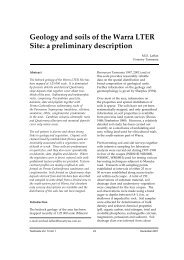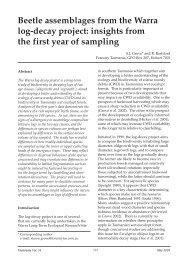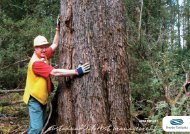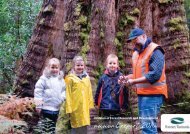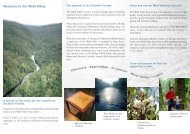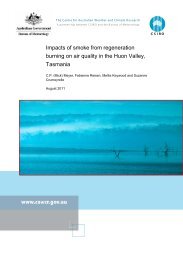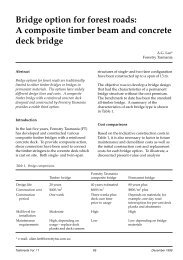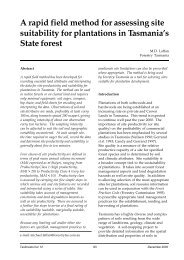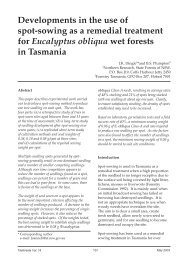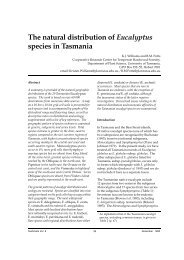annual report 2011 - Forestry Tasmania
annual report 2011 - Forestry Tasmania
annual report 2011 - Forestry Tasmania
You also want an ePaper? Increase the reach of your titles
YUMPU automatically turns print PDFs into web optimized ePapers that Google loves.
chief scientist’s <strong>report</strong><br />
Dr Steve Read<br />
Steve.Read@forestrytas.com.au<br />
Research has been described as the conversion of dollars<br />
into knowledge, whereas innovation is the subsequent<br />
conversion of that knowledge into a greater amount of<br />
dollars. The research and development group in any<br />
commercial organisation will thus thrive only while it<br />
can successfully argue that its work has positive impact<br />
on commercial outcomes. The front cover of this <strong>report</strong><br />
illustrates a collaborative project in which the <strong>Forestry</strong><br />
<strong>Tasmania</strong> plantation research team is following a plantation<br />
stand and genetics trial though timber milling to the<br />
final product and then its market uptake. With increasing<br />
volumes of plantation timber becoming available, the<br />
links between genetics, silviculture and product value can<br />
be directly investigated, resulting not just in the ability to<br />
grow better trees, but also in development of processing<br />
approaches specific to this new resource, and new markets.<br />
This year also saw a focus on the cost-effectiveness of<br />
the integrated leaf-beetle management program run by<br />
<strong>Forestry</strong> <strong>Tasmania</strong>’s forest health surveillance team. Both<br />
larvae and adults of the <strong>Tasmania</strong>n eucalypt leaf beetle<br />
Paropsisterna bimaculata consume the foliage of plantation<br />
eucalypts, and an extensive <strong>annual</strong> monitoring program,<br />
linked to modelling of potential timber volume losses,<br />
determines the coupes in which management actions<br />
will be undertaken. Analysis of data entered by Districts<br />
into the Forest Operations Database showed that each<br />
$1 spent on the program averted timber losses of $1.76<br />
(net present value). The work also showed these financial<br />
benefits would almost double with a program that was<br />
more targeted and that extended into older plantations.<br />
Research programs that have strategic benefit, or maintain<br />
access to forest resources, are of course not as amenable<br />
to this kind of analysis, so alternative ways of determining<br />
their impact need to be developed, but the ability to show<br />
savings greater than the research spend is an important<br />
incentive to maintain research and development capacity.<br />
Another exciting achievement this year was seeing the<br />
<strong>Tasmania</strong>n Forest Insect Collection website (www.tfic.<br />
net.au) go live. Beetles have a key role both in forest<br />
biodiversity and as forest pests, and the TFIC, a satellite<br />
collection of the <strong>Tasmania</strong>n Museum and Art Gallery,<br />
was developed by <strong>Forestry</strong> <strong>Tasmania</strong> because of the<br />
importance of beetles and other insects in many of our<br />
research programmes. The TFIC web-site contains a page<br />
for each beetle species, with individual photographs as<br />
well as automatically generated distribution maps, and is a<br />
valuable resource for researchers and collaborators.<br />
Formal conclusion and acceptance by the Commonwealth<br />
of the Alternatives to Clearfelling research program of the<br />
<strong>Tasmania</strong>n Community Forest Agreement also occurred<br />
in 2010/11. While clearfell, burn and sow is a practical<br />
approach to harvesting wet eucalypt forests, and gives<br />
good regeneration, repeated applications will lead to<br />
coupe-level losses of mature-forest species and structures<br />
that would survive into stands regenerating following<br />
natural wildfire. The proven alternative, aggregated<br />
retention, was developed by reference to the spatial<br />
patterns of the occasional, intense wildfires that are the<br />
natural disturbance regimes in <strong>Tasmania</strong>’s wet sclerophyll<br />
and mixed forests, and allows coupe-scale persistence<br />
of mature-forest biodiversity, facilitates recolonisation of<br />
harvested areas by mature-forest species, and provides<br />
connectivity across the developing forest stand: it<br />
complements the reservation of forests elsewhere in the<br />
landscape.<br />
More than 50 aggregated retention coupes have been<br />
harvested in mature forest across <strong>Tasmania</strong> in the last<br />
few years, and Robyn Scott is continuing to describe the<br />
nature of the regenerating stands. Combining the Warra<br />
Silvicultural Systems Trial with analysis of ecological metrics<br />
in operational coupes has provided <strong>Forestry</strong> <strong>Tasmania</strong> with<br />
a fresh and practical approach to adaptive management.<br />
Our learning in regard to monitoring ecological outcomes<br />
can now be applied to harvesting of younger forests of<br />
smaller trees for a range of newer products.<br />
Fire - a driver of the dynamics of eucalypt ecosystems<br />
6




